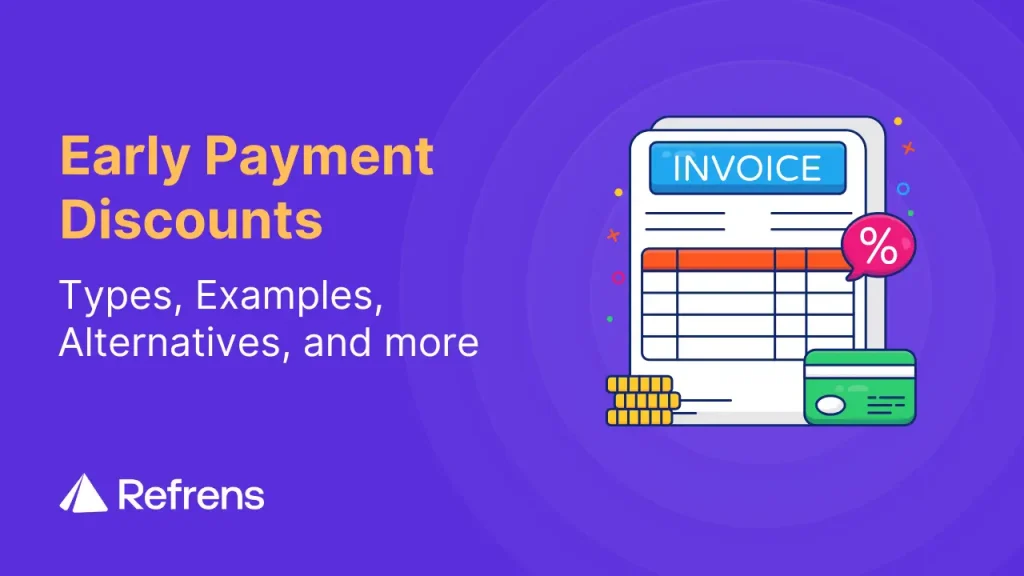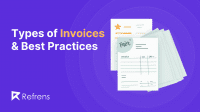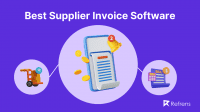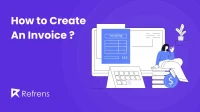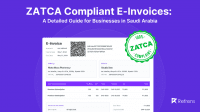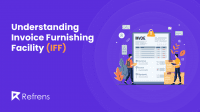What Are Early Payment Discounts?
An Early Payment Discount (EPD) is a financial incentive offered by a supplier to a buyer, encouraging the buyer to pay an invoice before its due date. In exchange for early payment, the buyer receives a reduction in the total invoice amount.
This arrangement benefits both parties: the supplier accelerates cash inflow, and the buyer reduces procurement costs.
Example:
A common EPD term is 2/10, net 30. This means the buyer can take a 2% discount if the invoice is paid within 10 days; otherwise, the full amount is due in 30 days.
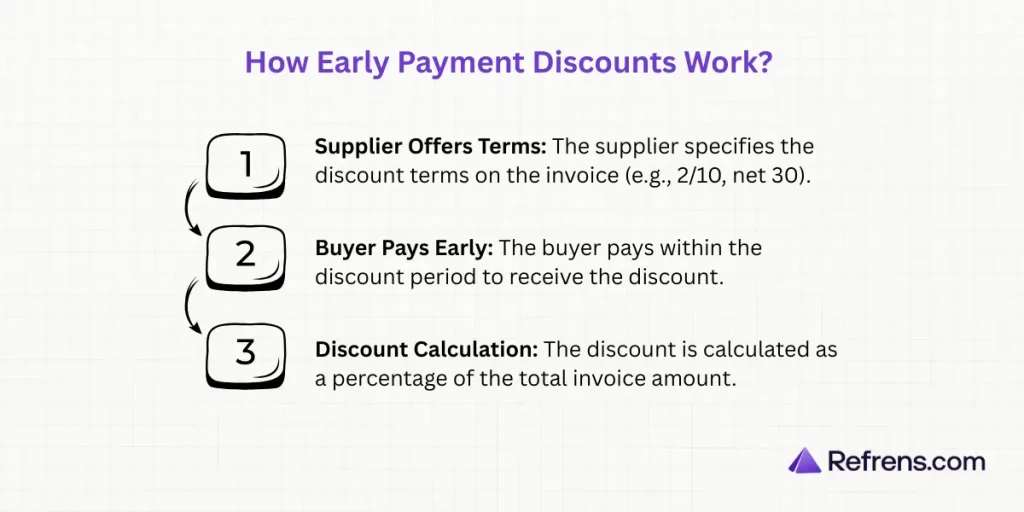
Types of Early Payment Discounts
| Sr. No. | Type of Discount | Definition | Example | Remarks |
| 1 | Static Discount | A fixed percentage discount if payment is made within a specific timeframe (e.g., 2/10, net 30). | Invoice terms: 2/10, net 30. If a $10,000 invoice is paid within 10 days, the buyer pays only $9,800 (2% discount). If paid after 10 days, the full $10,000 is due. | Common across industries for simplicity and predictability. |
| 2 | Sliding Scale Discount | The discount percentage decreases as the payment date approaches the due date. | The earlier the payment, the bigger the discount: 4% discount if paid within 5 days, 3% if paid within 10 days, 2% if paid within 20 days, so on… | Offers flexibility to buyers and helps suppliers manage liquidity. |
| 3 | Dynamic Discount | Discounts are negotiated in real-time based on the payment date, often managed through automation platforms. | 2% discount if paid on day 5, but the discount drops to 1.2% if paid on day 12. The exact rate is determined in real-time, often via automation platforms. | Highly flexible, suitable for large invoices or industries with fluctuating cash flow demands. |
| 4 | Fixed Amount Discount | A flat amount reduction for early payment, regardless of invoice size. | $100 off the invoice if payment is made within 7 days, regardless of the total invoice amount. | Suitable for smaller or standardized transactions. |
| 5 | Tiered Discount | Multiple discount levels based on specific payment thresholds. | Multiple discount levels based on how quickly payment is made: 5% discount if paid within 5 days, 3% if paid within 10 days, 1% if paid within 15 days. | Strongly incentivizes earlier payments by offering higher discounts for quicker payments. |
| 6 | Conditional Discount | Discounts are tied to specific conditions, such as volume commitments. | 2% discount if the buyer commits to purchasing at least $50,000 worth of goods over the next quarter and pays invoices within 10 days. | Encourages bulk purchases. |
| 7 | Seasonal Discount | Discounts are tied to specific periods, such as holidays OR FY-end. | 3% discount on all invoices paid within 7 days during the holiday season, OR at the FY end to boost cash flow. | Encourages quick payments during specific periods. |
| 8 | Trade Credit Discount | Credits toward future purchases for early payment of past invoices. | If a buyer pays their previous invoice 15 days ahead of schedule, they receive a $500 credit toward their next order, which can be applied as a discount on future purchases. | Strengthens long-term supplier relationships. |
| 9 | Non-Monetary Discount | Incentives such as free shipping, extended warranties, or bonus inventory for early payments. | Pay within 10 days to get an extended warranty OR free products. | Useful for suppliers who want to improve cash flow without reducing invoice revenue. |
Benefits of Early Payment Discounts
- Accelerated Cash Flow: Early payment discounts allow suppliers to receive payments sooner, improving liquidity and reducing the strain of waiting for standard payment terms
- Reduced Risk of Nonpayment: Early payments lower the risk of late or nonpayment, providing greater financial stability
- Improved Working Capital: Suppliers can use the early influx of cash to manage operational expenses, pay employees, or invest in growth opportunities
- Better Control Over Financial Metrics: Early payment programs help suppliers manage key metrics like Days Sales Outstanding (DSO), improving overall financial health
- Stronger Customer Relationships: Offering early payment discounts builds trust and loyalty with buyers, leading to repeat business and long-term partnerships
- Competitive Advantage: Suppliers offering early payment discounts may gain an edge over competitors by reducing the risk of nonpayment and fostering stronger relationships with buyers
- Reduced Administrative Costs: Early payments reduce the need for follow-ups on overdue invoices, lowering accounts receivable management costs
Drawbacks of Early Payment Discounts
- Reduced Revenue: Discounts directly reduce total revenue, impacting profit margins.
- Wasted Incentives: If customers pay on time without needing a discount, offering one may result in unnecessary revenue loss.
- Customer Exploitation: Some customers may take discounts without adhering to payment timelines.
- Management Complexity: Requires careful oversight, especially for smaller businesses.
- Unpredictable Cash Flow: Discounts are optional for buyers, so suppliers cannot always rely on them.
Accounting and Tax Considerations
- Recording Discounts
Gross Method: Record the full invoice amount initially; apply the discount when payment is made.
Net Method: Record the invoice amount with the discount applied upfront; adjust if the discount is not utilized.
- Journal Entries
Without Discount: Debit Accounts Receivable, Credit Revenue.
With Discount: Debit Cash (discounted amount), Debit Sales Discounts (contra-revenue account), Credit Accounts Receivable (full invoice amount).
Contra-Revenue Account: Discounts are recorded in a “Sales Discounts” account, reducing gross revenue and ensuring accurate financial reporting.
- Tax Implications
Discounts are generally treated as a reduction in revenue and taxed accordingly. In some jurisdictions, VAT or GST may need to be calculated before applying the discount. Tax implications may vary by jurisdiction; consult local regulations for specifics.
Alternatives to Early Payment Discounts
1. Supply Chain Financing (SCF)
Supply Chain Financing (also known as supplier finance or reverse factoring) is a financial arrangement where suppliers receive early payments on their invoices from a third-party financial institution (such as a bank or fintech), while buyers maintain their standard payment terms. The financing cost is typically based on the buyer’s creditworthiness rather than the supplier’s.
Benefits
- Improves supplier liquidity by providing faster access to cash, reducing financial strain and risk of supply chain disruptions.
- Allows buyers to extend payment terms without negatively impacting suppliers, optimizing working capital for both parties.
- Strengthens supplier relationships and enhances supply chain stability.
Drawbacks
- Involves third-party fees or interest, which may be higher than the cost of early payment discounts.
- Implementation can be complex, requiring coordination among buyers, suppliers, and financial institutions.
- Suppliers are dependent on buyer invoice approval to access early payments.
2. Accounts Receivable Financing (Factoring)
Accounts Receivable Financing (or Factoring) is a process where suppliers sell their outstanding invoices (accounts receivable) to a factoring company at a discount, receiving immediate cash instead of waiting for customers to pay
Benefits
- Provides immediate cash flow, helping suppliers cover operational expenses or invest in growth.
- No new debt is incurred, as it is an advance on money already owed to the business.
- Outsources the collection process to the factoring company, reducing administrative burden.
Drawbacks
- Factoring fees can be significant (often 1–5% of invoice value), potentially higher than early payment discount costs.
- Suppliers receive less than the full invoice value, reducing profit margins.
- May impact customer relationships if the factoring company’s collection practices are aggressive
3. Trade Credit
Trade credit is an arrangement where suppliers allow buyers to purchase goods or services on credit, deferring payment to a later date (e.g., 30, 60, or 90 days) without incurring interest.
Benefits
- Enables buyers to delay payment, improving their cash flow and increasing purchasing power.
- Can help buyers manage larger orders or seasonal demand without immediate cash outlay.
- May foster stronger business relationships and provide a competitive edge for suppliers offering favorable terms.
Drawbacks
- Suppliers must wait longer for payment, which can strain their own cash flow and working capital.
- Increases the risk of nonpayment or bad debts for suppliers.
- Managing trade credit involves additional administrative tasks, such as credit checks and collections.
4. Bank Loans or Lines of Credit
Bank loans provide a lump sum of money to be repaid over time with interest, while lines of credit offer flexible, revolving access to funds up to a set limit. Businesses can use these funds to pay suppliers on time or early, without relying on early payment discounts.
Benefits
- Offers flexibility and immediate liquidity to manage cash flow and ensure timely supplier payments.
- Loans can provide access to larger funding amounts for operational or growth needs.
- Using borrowed funds to pay suppliers on time can strengthen supplier relationships without offering discounts.
Drawbacks
- Involves interest costs and potential fees, which may exceed the savings from early payment discounts.
- Loans and lines of credit may require collateral and a strong credit history, and can increase business debt.
- Rigid repayment terms (for loans) or risk of overuse (for lines of credit) can strain cash flow if not managed carefully
Why Automate Early Payment Discounts (and How Refrens Can Help)
Managing early payment discounts manually can be time-consuming, error-prone, and often leads to missed savings or strained supplier relationships. Automation ensures you never miss a discount opportunity, streamlines your accounts payable process, and provides real-time visibility into your cash flow.
By automating early payment discounts, you can consistently capture cost savings, reduce administrative burdens, and strengthen your business partnerships.
Refrens makes this process effortless. With Refrens AI Accounting Software, you can automate invoice processing, track discount deadlines, and ensure timely payments – all from a single, easy-to-use platform. This not only maximizes your savings but also frees up your team to focus on strategic growth.
Try Refrens for Free >

